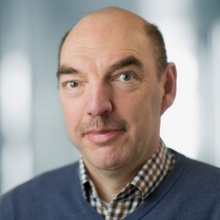Waves can be found in a wide variety of systems and exhibit many differnt shapes. There are gravitational waves, electromagnetic waves, water waves, etc. Also influenza spreading, modeled by a reaction-diffusion system, is a wave phenomenon. There are one-dimensional, two-dimensional and three-dimensional waves. There are waves with a fixed wave profile, modulated waves, shock waves, fronts, etc. Most of these waves can be described as solutions to nonlinear partial differential equations. In a co-moving coordinate frame these waves can be stationary or time-periodic solutions. The existence, stability or interaction of such waves is part of our research.
Are there any practical applications for this research studies?
With the aid of the maximum principle, the propagation velocity of fronts can be determined in reaction-diffusion systems. This provides information on the speed at which epidemics spread. For example, the size of the area in which rabies vaccination is required can be determined.
The analysis of the water wave problem yields simple models for the spread of Tsunamis, which can extremely accurately predict in between a few minutes the time of arrival of these destructive water waves at the coast lines.
In multiplexing, the data rate for the transmission of information via opical fibers is increased by the fact that light is transmitted with different carrier frequencies through the same cable.
Only if the interaction of the waves with different carrier frequencies is understood, data spaghetti can be prevented at the end of the cable.
What research about waves is conducted at the Chair of Analysis and Modelling?
The chair is an external member of the Collaborative Research Center 1173 at KIT on wave phenomena. Among other topics within this collaborative research center wave propagation in periodic media is investigated. These investigations are motivated by the propagation of light in so-called photonic crystals or the propagation of electromagnetic waves in structures such as nanotubes or graphene.
Due to its periodic structure, it is in principle possible to slow light down to speed zero. The aformentional crystals could be used to store light. In recent years, we have demonstrated the existence of standing time-periodic localized solutions for the associated nonlinear partial differential equations. This was quite surprising, since in the spatially homogeneous case the non-existence of such so-called breather solutions is well-known. In a new project the existence of migrating generalized breather solutions in periodic media shall be proved. In the co-moving coordinate frame these solutions are quasiperiodic.
Questions of stability will also be investigated in this project.
Thank you for the interview.
Prof. Guido
Schneider
Institute of Analysis, Dynamics and Modelling
Chair for Analysis and Modelling


